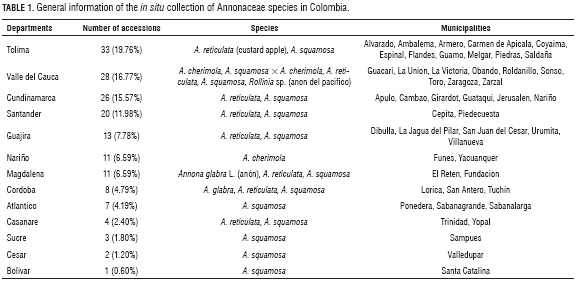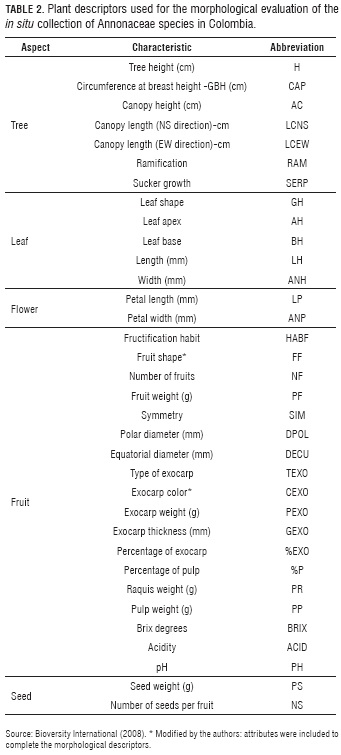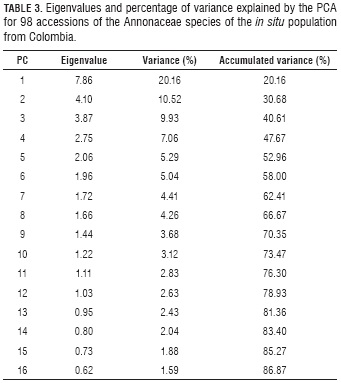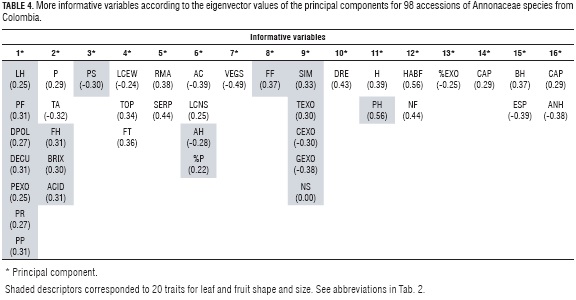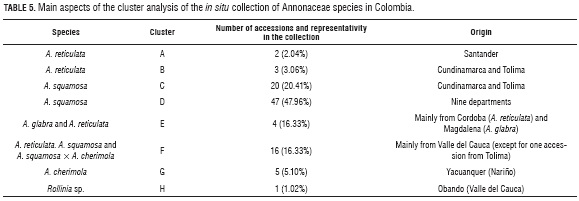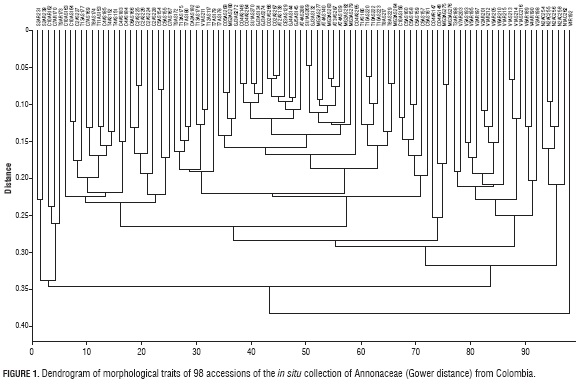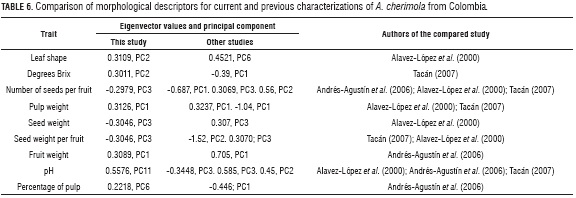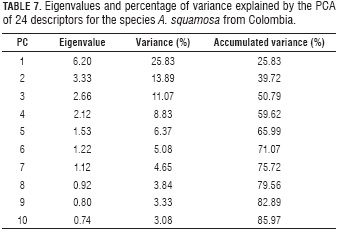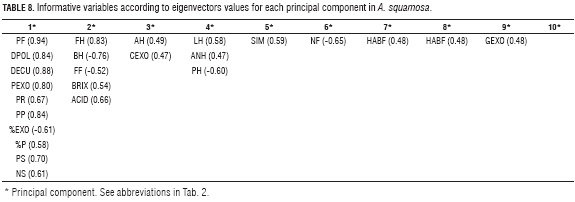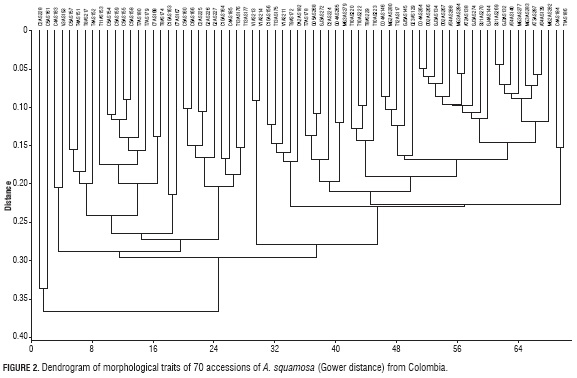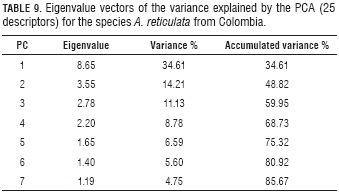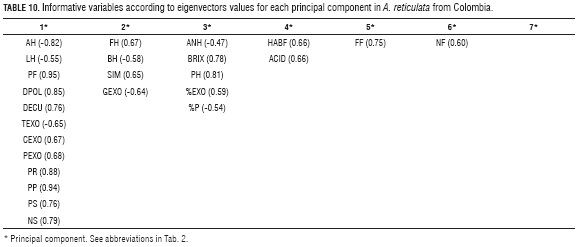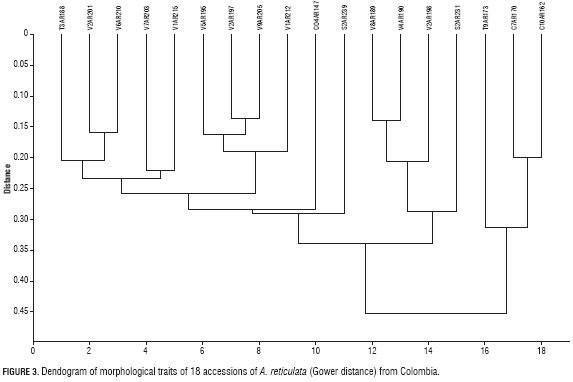Services on Demand
Journal
Article
Indicators
-
 Cited by SciELO
Cited by SciELO -
 Access statistics
Access statistics
Related links
-
 Cited by Google
Cited by Google -
 Similars in
SciELO
Similars in
SciELO -
 Similars in Google
Similars in Google
Share
Agronomía Colombiana
Print version ISSN 0120-9965
Agron. colomb. vol.34 no.2 Bogotá May/Aug. 2016
https://doi.org/Doi:10.15446/agron.colomb.v34n2.54527
Doi: http://dx.doi.org/10.15446/agron.colomb.v34n2.54527
Morphological evaluation of an in situ collection of species from the Annonaceae family in Colombia
Evaluación morfológica de una colección in situ de especies de la familia Annonaceae en Colombia
Sandra Liliana Castañeda-Garzón1, Gustavo Adolfo Ligarreto M.2, and Diego Miranda-Lasprilla2
1 Scientific sub-directory, Jardín Botánico de Bogotá José Celestino Mutis. Bogotá (Colombia). slcastanedag@unal.edu.co
2 Department of Agronomy, Faculty of Agricultural Sciences, Universidad Nacional de Colombia. Bogotá (Colombia).
Received for publication: 17 November, 2015. Accepted for publication: 30 June, 2016.
ABSTRACT
An in situ collection composed of 167 accessions of the species Annona cherimola, A. glabra, A. reticulata, and A. squamosa, Rollinia sp., and the interspecific hybrid A. squamosa x A. cherimola was established through bioprospecting of genetics resources of the Annonaceae family in the Colombian Andean and Caribbean regions. These accessions were distributed in 13 departments and 48 municipalities. The most representative species of this collection are A. squamosa and A. reticulata, which are derived from traditional cultivars of populated centers with a variable altitude range of up to 1,021 m a.s.l. The morpho-agronomic evaluation was carried out on 98 accessions using 25 qualitative and quantitative descriptors, which identified the phenotypic traits in A. squamosa and A. reticulata that are related to fruit quality, such as size, weight, symmetry, degrees Brix, pH, acidity, seed weight and seed number, which are the more discriminating descriptors, differentiating six clusters in A. squamosa and four clusters in A. reticulata.
Key words: Annona reticulata, Annona squamosa, genetic plant resources, germoplasm.
RESUMEN
A partir de la prospección de recursos fitogenéticos de la familia Annonaceae en las Regiones Andina y Caribe colombiano, se conformó una población in situ de 167 accesiones de las especies: Annona cherimola, A. glabra, A. reticulata, A. squamosa, Rollinia sp. y del híbrido interespecífico A. squamosa x A. cherimola, distribuidas en 13 departamentos y 48 municipios. Las especies más representativas en la población son A. squamosa y A. reticulata, conformadas por cultivares tradicionales de centros poblados de un rango altitudinal variable hasta 1.021 msnm. La evaluación morfoagronómica se realizó en 98 accesiones a través de 25 descriptores cuantitativos y cualitativos, permitió identificar en A. squamosa y A. reticulata, que los rasgos fenotípicos que se relacionan con la calidad del fruto como tamaño, peso, simetría, grados Brix, pH, acidez, peso y número de semillas son los que diferencian los seis agrupamientos conformados para A. squamosa y los cuatro para A. reticulata.
Palabras clave: Annona reticulata, Annona squamosa, recursos genéticos, germoplasma.
Introduction
The industrial and food significance of some species in the Annonaceae family (Agustín and Ledesma, 2014; Buriticá and Cartagena, 2015; Guerrero and Fischer, 2007; Moreno et al., 2013; Lemos, 2014) has led to the development of world-renowned commercial varieties, such as cherimoya (Annona cherimola Mill.) (Escribano et al., 2008) and atemoya (A. squamosa x A. cherimola), as a result of a long process of genetic improvement that has identified plants with commercially desirable agronomic characteristics that distinguish the fruit market of this family.
In Colombia, there have been few studies on species from the Annonaceae family and the studies that have been conducted focused on commercial species, such as Annona muricata L. (soursop), while ignoring other promising species, such as "anon" or sugar apple (A. squamosa) or recognized fruits such as cherimoya (A. cherimola). Other wild Annona species, with a native distribution that covers this country, still remain untapped. In the Annonaceae family, morphological studies have identified phenotypic traits (quantitative and qualitative) that characterize materials used in genetic improvement programs and that have been selected by fruit productivity and quality criteria (George et al., 1999).
The research that has been carried out on the Annonaceae family has contributed valuable information for the characterization process through the selection of morphological traits that have identified the phenotypic variability in an in situ population of A. cherimola trees (Alavez-López et al., 2000) and the phenotypic variability of A. cherimola fruits in the province of Loja-Ecuador (Morales et al., 2004).
Among the studies is to be emphasized the morphological evaluation of A. muricata germoplasm sampled in the Pacific and North of Nicaragua (Benavides, 2004), the incorporation of morphometric traits in the evaluation report of an A. cherimola germoplasm bank in Mexico (Andrés-Agustín et al., 2004) and the morphometric analysis of organs of A. cherimola and fruit parameters for the characterization of Campas, Burtons, and White cultivars, as well as selected Mexican germoplasm (Andrés-Agustín et al., 2006).
The descriptors developed for these species have been useful to evaluate an in situ collection of species from the Annonaceae family in Colombia, but also for the morpho-agronomic evaluation of A. muricata and A. cherimola ecotypes in fields and the Centro Agronómico Tropical de Investigación y Enseñanza (CATIE) collection in Costa Rica (Tacán, 2007) and for the evaluation of fruit yield and quality in an orchard of A. muricata L. trees (Evangelista-Lozano et al., 2003).
The latter reported on advances in the morphological evaluation of species of the family, in which in situ and ex situ collections of A. cherimola have been established. It has been noted that fruit and leaf characteristics are relevant traits for differentiating genotypes in germoplasm collections. The present study aimed to morphologically evaluate an in situ collection of species in the Annonaceae family from the Andean and Caribbean regions of Colombia in order to contribute to the knowledge and establishment of a pioneer Annonaceae germplasm collection.
Materials and methods
The in situ collection (167 accessions) was based on the paper "Design of the collection of three species of the genus Annona of interest to Colombia" (2009) prepared under the project "Establishment of the Colombia Anon (Annona squamosa L.) Germoplasm Collection", from the Universidad Nacional de Colombia (Parra, 2009). This process included selected accessions that had been collected before 2009, as well as selected material that had been collected for this study in 2010 and 2011 (Tab. 1).
Based on the information generated from the collection design, representative individuals from the Andean and Caribbean study areas were collected. During collection expeditions, individuals were selected to create the in situ collection that had little phytosanitary damage on the trunks, stems, leaves, flowers, and fruits, and, when possible, were in the process of blooming and fructification.
For the field identification and definition of accessions in the in situ collection, visits were made to home orchards, plots, and crops, where material from the species A. squamosa, A. glabra, A. reticulata, and A. squamosa x A. cherimola, including a few accessions from A. cherimola and A. purpurea (known as "soncoya"), were collected in areas with a natural distribution. The sample sites were visited on one or two occasions, the individuals were georeferenced with a gps, and the environmental site conditions and plant morphological traits were recorded.
In order to obtain more detailed information from the in situ collection, 67 descriptors were used for cherimoya (A. cherimola), as defined by Bioversity International (2008); 29 of the descriptors corresponded to passport information, six to site and environmental site conditions, seven to tree characteristics or plant descriptors, and 25 to plant traits, related to leaf, fruit, and seed shapes and sizes, which were employed in the morphological evaluation (Tab. 2). The data compiled for these descriptors made up the Annona in situ collection data base.
For the identification of accession groups according to their morphological similarity (Tapia and Legaria, 2007; Franco and Hidalgo, 2003), a general analysis of the available information on morphological descriptors for each accession was carried out, followed by a univariate statistical analysis at the inter and intraspecific levels (with measurements of central tendency and dispersion), as well as an intraspecific multivariate statistical analysis with a principal components analysis -PCA- (quantitative and qualitative descriptors), cluster analysis with the UPGMA method-Unweighted Pair Group Method with Arithmetic Mean-, and Gower distance (Gower, 1971), using SAS® 9.1 and PAST 2.17 (Polly, 2007).
Results and discussion
Geographical distribution and habitat
The in situ collection was established primarily with germ-plams from cities and populated centers (52.69%), mostly with traditional cultivars (82.04%) that were not a part of crop systems (94.61%), given that the individuals were generally found in isolated conditions in plots or farms. During germplasm collection activities, the species A. squamosa was found as well-established crop only in the municipality of Apulo (Cundinamarca). Regarding the environmental site descriptors compiled for the in situ collection, the predominant agriculture type corresponded to 51.50% natural trees and shrubs and 40.70% general urban vegetation in the collection site and surrounding areas.
Interspecific morphological variability
The interspecific univariate analysis of 98 accessions (from all of the species) with 39 plant descriptors represented more than 80% of the information. In addition, there was no symmetry in the data and high dispersion was observed because of the variability of some descriptors, such as leaf length and width, fruit shape, polar and equatorial diameter, exocarp type and thickness, degrees Brix, acidity, pH, and exocarp and pulp percentage.
The interspecific multivariate analysis of the accession groups with 98 accessions showed that the first 16 components contributed 86.87% of the total variability (Tab. 3). Nonetheless, the components related to leaf and fruit morphological characteristics had the highest contribution to the analysis and corresponded to 20 of the 25 descriptors for leaf and fruit shape and size (Tab. 4). In this case, the first three components explained 40.61% of the variation.
The morpho-agronomic analysis of the in situ collection of Annonaceae species (A. cherimola, A. squamosa x A. cherimola, A. glabra, A. reticulata, A. squamosa, and Rollinia sp.) showed that the quantitative characteristics of the fruit, such as weight, polar and equatorial diameter, exocarp, raquis, and pulp weight, degrees Brix, acidity, and seed weight contributed more to the variation based on the coefficient of variation.
The cluster analysis of the set of Annonaceae accessions (A. cherimola, A. glabra, A. reticulata, A. squamosa, A. squamosa x A. cherimola and Rollinia sp.) showed six groups, at a Gower distance of 0.26, which supported the difference between the species based on their morphological affinity. The groups were characterized by clusters of same species individuals, according to qualitative morphological characteristics of the leaves and fruits. In this case, the quantitative characteristics had variation between the groups, except for group H, which contained the only Rollinia sp. accession and had the higher values for most descriptors (Tab. 5, Fig. 1). This analysis was developed by suggestion of experts, aiming to corroborate the morphological differences between species and provide statistical support of the in situ collection.
The latter was markedly observed for the species A. reticu-lata from Santander, Cundinamarca and Tolima, Córdoba and Valle del Cauca, which can be clearly differentiated into groups A, B, E, and F. Meanwhile, the species A. squamosa had the greatest representation in group D and originated from different provinces of Colombia. On the other hand, the species Rollinia sp. and A. cherimola were located in dissimilar groups (H and G, respectively) and, in other cases, some cluster groups (E and F) of accessions of more than one species were seen, but their geographical distribution is specific to one department (Tab. 5, Fig 1). This could be due to the centralized sampling strategy that was used and the progressive incorporation of individuals from other species during collection.
The descriptors that had higher contribution to the phenotypic variability in Annonaceae species in other collections of A. cherimola, matched with the descriptors used in this study, included: leaf shape, degrees Brix, number of seed per fruit, pulp weight, seed weight per fruit, fruit weight, pH, and percentage of pulp (Tab. 6). This information is useful to compare results from the characterization and morphological evaluation process of the collection established in this study and other previous efforts.
Intraspecific morphological variability
For the species A. squamosa, the principal components analysis included 24 descriptors that were related to commercially defined fruit quality parameters. The descriptors did not include exocarp type because it behaved as a constant in the univariate analysis. The PCA revealed that the first 10 components contributed 85% of the total variability (Tab. 7). The more informative variables were fruit weight, polar and equatorial diameter, exocarp weight, raquis and pulp weight, exocarp and pulp percentage, seed weight, and number of seeds (Tab. 8).
The cluster analysis identified six accession groups, at a Gower distance of 0.28. These groups did not reflect any relationship with the geographic origin of the accessions, but there was evidence of the morphological differences of fruits and seeds between species. Groups C and D contained most of the accessions of A. squamosa (Fig. 2), followed by Group F, with clusters of some accessions of A. squamosa, A. reticulata and A. squamosa x A. cherimola. Additionally, groups A and B contained accessions of A. reticulata, and groups G and H had some accessions of A. cherimola, Rollinia sp.
These clusters could be explained by the flow of materials within the country's regions as a result of the historical anthropic selection of these perennial fruits. According to Gepts (2002), this type of selection has taken place in domestication processes in order to increase species adaptation to crop conditions and the use of harvest products, such as grains, fruits, and fibers. However, Lobo et al. (2007), based on their study on the characterization of A. cherimola and A. muricata seed germination and latency, stated that "perennial fruits are species in an initial domestication process, derived from the fact that most of these species have turned from being wild type plants to cultivated plants, with a syndrome of incomplete domestication" (Gepts, 2002).
For the species A. reticulata, the principal components analysis included 25 descriptors related to commercially defined fruit quality parameters. The PCA revealed that the first seven components contributed 86% of the total variability and showed eigenvalues above 1 (Tab. 9). Based on the eigenvalue vectors, the more informative variables were leaf length and apex, fruit weight, polar and equatorial diameter, exocarp type, color, and weight, raquis weight, pulp and seed, and number of seeds (Tab. 10).
The cluster analysis identified four accession groups, at a Gower distance of 0.32. These groups did not reflect any relationship with the geographic origin of the accessions. Group A contained the greatest number of accessions, from the departments of Tolima, Valle del Cauca, Santander, and Córdoba (Fig. 3), while the rest of the groups contained few accessions.
The detailed analysis of the six and four accession groups of A. squamosa and A. reticulata, respectively, showed that the phenotypic traits defined the principal homologies and differences between the groups, which, for sugar apple, are basically due to fruit quality (size, weight, symmetry, degrees Brix, pH, acidity, and seed weight and number).
In the in situ collection, the accessions of A. squamosa and A. reticulata showed a morphological-geographical association, given that the accessions from the Caribbean region and a few from the Andean region are located in a big group. On the contrary, a number of accessions of the two more representative species of the collection, from Cundinamarca, Tolima and Valle del Cauca, were grouped in different clusters and their morphological characteristics are relevant for marketing and consumption. The clustering of the accessions according to their morphological and origin similarity could be attributed to the interaction between the genotype and the environment from which the individuals came from. However, complementary studies on these aspects must be conducted in order to derive conclusions on this topic.
A comparison of the physical characteristics of genotypes of the in situ anon (A. squamosa) collection in Colombia with A. squamosa genotypes in Brazil revealed that the average number of seeds per fruit varied between 13 and 84, which is equal to the value variation obtained by Cavalcante et al. (2011), who found a variation between 11 and 47 seeds per fruit among genotypes of an active germoplasm bank.
Although the population in this study, with 70 accessions from 10 departments, was much greater than that obtained by the Brazilian researchers, with 12 genotypes from one municipality, the reference values found by the Brazilian researchers were useful in this study as a measure of productivity in A. squamosa.
In the in situ collection, the comparison of the A. squamosa fruit shape with the relationship between longitudinal and transversal fruit diameters (relation DL/DT) showed values between 0.76 and 1.03, which produced round fruits suitable for the fruit market. According to Silva et al. (1998), fruits are round when the value nears 1.0, a favorable trait for quality fruit markets, and a relevant characteristic for freshly consumable anon. Cavalcante et al. (2011) conducted the same comparison in A. squamosa genotypes and found that these fruits met the characteristics required by the Brazilian market. This relationship may be taken into consideration in future research.
Although this study did not evaluate the genotype x environment interaction, the intraspecific morphological variations could have been partly due to the wide geographical distribution of the accessions and the different environmental characteristics of the collection sites.
Conclusions
The morphological traits that contributed to the differentiation of the A. squamosa accessions included fruit weight, polar and equatorial diameter, exocarp weight, raquis and pulp weight, exocarp and pulp percentage, and seed weight and number. On the contrary, for A. reticulata, leaf length and apex, as well as exocarp type and color, were the traits that contributed to the differentiation of this species.
The intraspecific morpho-agronomic evaluation of the in situ population of Annonaceae in Colombia revealed ten accession groups of A. squamosa and A. reticulata, six and four, respectively, that were characterized by similarities in traits such as fruit size, weight, symmetry, Brix degrees, pH, and acidity, in addition to seed weight and number.
For A. reticulata and A. squamosa, superior category fruits (cordiform, symmetrical, greater weight and a Brix degrees content above 15°) were found in the departments of Cundinamarca and Tolima, while, for Rollinia sp. and A. squamosa x A. cherimola, they were found in Valle del Cauca. Most of the fruits of the species assessed in the in situ population were classified as common because their characteristics differed greatly from those required by the international fruit market.
Acknowledgements
We thank the Faculty of Agricultural Sciences, Universidad Nacional de Colombia, Bogotá and the Ministerio de Agricultura y Desarrollo Rural for financing this research, and the species producers and researchers who were the sources of the secondary information and plant material currently consolidated in this study.
Literature cited
Agustín, J.A. and S.D.S. Ledesma. 2014. Conservación y uso de los recursos genéticos de Annonaceae en México. Rev. Bras. Frutic. 36, 118-124. Doi: 10.1590/S0100-29452014000500014. [ Links ]
Alavez-López, M.J., J.G. Cruz-Castillo, L.M. Marroquín-Andrade, and M. Rubí-Arriaga. 2000. Horticultural characterization of cherimola trees in situ. Rev. Chapingo, Ser. Hortic. 6, 179-193. [ Links ]
Andrés-Agustín, J., F. González-Andrés, R. Nieto-Ángel, and A.F. Barrientos-Priego. 2006. Morphometry of the organs of cherimoya (Annona cherimola Mill.) and analysis of fruit parameters for the characterization of cultivars, and Mexican germplasm selections. Sci. Hortic. 107, 337-346. Doi: 10.1016/j.scienta.2005.11.003. [ Links ]
Andrés-Agustín, J., R. Nieto-Ángel, A.F. Barrientos-Priego, M.T. Martínez-Damián, F. González-Andrés, S.D. Segura-Ledesma, J.G. Cruz-Castillo, and C. Gallegos-Vázquez. 2004. Variación morfológica de la hoja del chirimoyo. Rev. Chapingo, Ser. Hortic. 10, 103-110. [ Links ]
Benavides G., A. 2004. Caracterización numérica de germoplasma de guanábana (Annona muricata L.) muestreado in situ en el Pacífico y Norte de Nicaragua. La Calera 10, 29-35. [ Links ]
Bioversity International. 2008. Descriptores para cherimoyo (Annona cherimola Mill.). FAO, Rome. [ Links ]
Buriticá C., P. and J.R. Cartagena V. 2015. Neotropical and introduced fruits with special tastes and consistencies that are consumed in Colombia. Rev. Fac. Nal. Agr. Medellín 68, 7589-7618. Doi: 10.15446/rfnam.v68n2.50948. [ Links ]
Cavalcante, Í.H.L., M.C.S. Moura, L.F. Rocha, G.B. Silva Júnior, L.V. Martins, and R.R.S. Silva. 2011. Seleção preliminar de genótipos de pinheira em Bom Jesus-PI. Rev. Ciênc. Agrár. 34, 173-181. [ Links ]
Escribano, P., M.A. Viruel, and J.I. Hormaza. 2008. Comparison of different methods to construct a core germplasm collection in woody perennial species with simple sequence repeat markers. A case study in cherimoya (Annona cherimola, Annonaceae), an underutilised subtropical fruit tree species. Ann. Appl. Biol. 153, 25-32. Doi: 10.1111/j.1744-7348.2008.00232.x. [ Links ]
Evangelista-Lozano, S., J.G. Cruz-Castillo, S. Pérez-González, E. Mercado-Silva, and G. Dávila-Ortiz. 2003. Producción y calidad frutícola de guanábanos (Annona muricata L.) provenientes de semilla de Jiutepec, Morelos, México. Rev. Chapingo, Ser. Hortic. 9, 69-79. [ Links ]
Franco, T.L. and R. Hidalgo (eds.). 2003. Análisis estadístico de datos de caracterización morfológica de recursos fitogenéticos. Tech. Bull. No. 8. Instituto Internacional de Recursos Fitogenéticos (IPGRI), Rome. [ Links ]
George, A.P., R.H. Broadley, R.J. Nissen, S.D. Hamill, and B.L. Topp. 1999. Breeding strategies for atemoya and cherimoya. Acta Hortic. 497, 255-268. Doi: 10.17660/ActaHortic.1999.497.13. [ Links ]
Gepts, P. 2002. A comparison between crop domestication, classical plant breeding, and genetic engineering. Crop Sci. 42, 1780-1790. Doi: 10.2135/cropsci2002.1780. [ Links ]
Gower, J.C. 1971. A general coefficient of similarity and some of its properties. Biometrics 27, 857-871. Doi: 10.2307/2528823. [ Links ]
Guerrero, E.J. and G. Fischer. 2007. Manejo integrado en el cultivo de anón (Annona squamosa L.). Rev. Colomb. Cienc. Hortic. 2, 154-169. Doi: 10.17584/rcch.2007v1i2.1157. [ Links ]
Lemos, E.E.P. 2014. A produção de anonáceas no Brasil. Rev. Bras. Frutic. 36, 77-85. Doi: 10.1590/S0100-29452014000500009. [ Links ]
Lobo, M., O. Delgado, J.R. Cartagena, E. Fernández, and C.I. Medina. 2007. Categorización de la germinación y la latencia en semillas de chirimoya (Annona cherimola L.) y guanábana (Annona muricata L.), como apoyo a programas de conservación de germoplasma. Agron. Colomb. 25, 231-244. [ Links ]
Morales A., A.R., B. Cueva C., and P.S. Aquino V. 2004. Genetic diversity and geographic distribution of Annona cherimola in Southern Ecuador. Lyonia 7, 159-170. [ Links ]
Moreno B., N.E., D. Miranda, and F.E. Martínez M. 2013. Germinación de semillas de anón (Annona squamosa L.) sometidas a estratificación. Rev. Colomb. Cienc. Hortic. 7, 20-30. Doi: 10.17584/rcch.2013v7i1.2032. [ Links ]
Parra Q., M. 2009. Diseño de colecta de tres especies de ínteres agrícola del género Annona para Colombia. Faculty of Agronomy, Universidad Nacional de Colombia, Bogotá [ Links ].
Polly, D. 2007. Paleontological data analysis. Hammer and D. Harper (eds). Publisher: Blackwell Publishing, Oxford, 2005 (351 pp.) ISBN: 1-4051-1544-0. J. Quaternary Sci. 22, 652. Doi: 10.1002/jqs.1107. [ Links ]
Tacán P., M.V. 2007. Caracterización agromorfológica e identificación de zonas potenciales de conservación y producción de guanábana (Annona muricata) y cherimoya (Annona cherimola) en fincas de agricultores y condiciones ex situ en Costa Rica. MSc thesis. Programa de Educación para el Desarrollo y la Conservación, Centro Agronómico Tropical de Investigación y Enseñanza (CATIE), Turrialba, Costa Rica. [ Links ]
Tapia P., D. and J.P. Legaria S. 2007. Variabilidad genética en cultivares de guayabo (Psidium guajava L.). Rev. Fitotec. Mex. 30, 391-401. [ Links ]
Silva, G.C., O.M.S. Andrade, F.A. Castro, and F.T. Sá. 1998. Instruções técnicas para o cultivo da Ateira. Tech. Instr. No. 01 dez./98, Embrapa Agroindústria Tropical, Fortaleza, Brasil. [ Links ]













